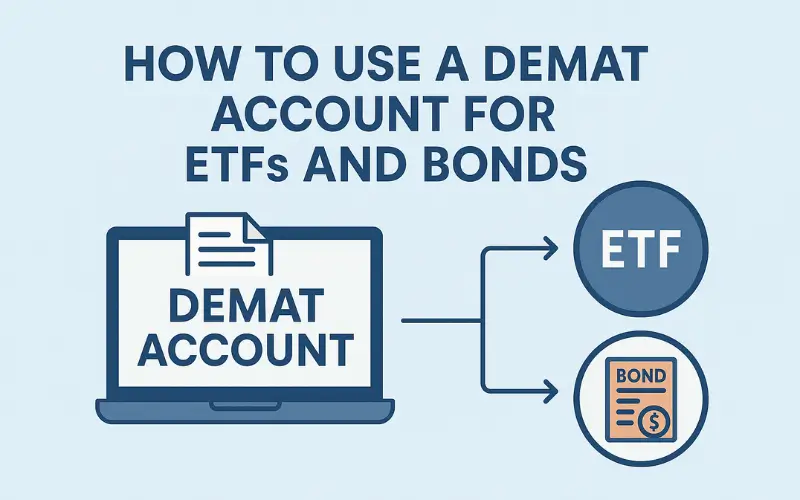In today’s digitally-oriented financial landscape, investing has become safer, simpler and more transparent than ever before. One of the main reasons for this smooth experience is with a Demat account – a digital container to hold financial securities in an electronic format. Demat accounts are equally crucial for investing in other instruments, such as Exchange Traded Funds (ETFs) and bonds.
This blog will cover how your Demat account works for ETFs and bonds, who it is essential for, and how to maximise its benefits and build a diversified portfolio of investments.
What is a Demat Account?
A Demat account is an electronic account that holds securities in an electronic format, without actual paper documents. Where you once had physical share certificates or bond papers, instead, your holdings would now be held electronically, in your name.
It is very similar to a bank account:
- A savings bank account that holds money.
- A Demat account that holds financial securities.
These securities include shares, & exchange-traded funds (ETFs), mutual funds, government securities, corporate bonds, as well as sovereign gold bonds (SGBs).
What are ETFs?
Exchange-traded funds are a type of mutual fund. Usually, an ETF tracks an index or sector and trades on an exchange just like stocks. ETFs are very much like a typical mutual fund, but, because they trade in the stock market, investors must have a demat account to transact.
Here are 2 features that make them unique from regular mutual funds:
- ETFs are traded on the stock exchange, but regular mutual funds are not.
- ETFs are passive mutual funds that usually track benchmark indices like Nifty or Sensex.
Why a Demat Account for ETFs and Bonds?
ETFs and bonds are becoming ever more desirable to investors:
- ETFs: They are marketable securities that aim to mimic the performance of an index, commodity, bond, or basket of assets.
- Bonds: It is a fixed-income financial instrument whereby you are effectively lending money directly to a government, municipality or corporation, and they will pay you interest regularly for the use of your money.
While bonds were historically issued in a physical certificate form, and ETFs were a niche type product, now, primarily due to the technological revolution, bonds and ETFs are mainly traded and held electronically.
A Demat account ensures:
- Security is at no risk of loss, theft, or damage of paper certificates.
- Faster settlement of transactions.
- Easy portfolio tracking in one place.
- Direct credit of bonds or ETFs to your linked bank account.
How to Use a Demat Account for ETFs
To start investing in ETFs through a Demat account, you’ll need to follow a few simple steps:
1. Open a Demat & Trading Account
- A Demat account serves the purpose of holding ETFs.
- Remember that a trading account is required to buy or sell ETFs on stock exchanges.
- Most brokers package these together.
2. Fund Your Trading Account
- Link your bank account to your trading account.
- Deposit funds into your account.
- Available balance will be used to purchase ETFs.
3. Choose the ETF that You Would Like to Invest in
ETFs come in a few different flavours:
- Index ETFs (such as Nifty 50 or S&P 500)
- Gold ETFs
- Debt ETFs
- Sectoral or Thematic ETFs (sectors such as banking, IT or energy).
- Make sure that before deciding on an ETF to invest in, you look at the expense ratio, liquidity and historical pricing.
4. Place Buy Order:
Log in to your broker’s trading platform:
- Search for the ETF ticker symbol.
- Follow a buy order process as you would for shares.
- Specify the quantity & price of ETF shares.
5. Settlement and Storage Process
- After execution of the transaction, settlement occurs in T + 1 days, or T + 2 days (Trade Day + 1 day, or 2 days).
- After the settlement, ETF units will be credited into your demat account.
- You can see and track these holdings through your broker platform.
6. Selling ETFs
- Access your trading account.
- Make a sell order for the ETF units you’d want to exit.
- The sale proceeds will be transferred to your connected bank account.
How to Use a Demat Account for Bonds
Bonds have some differences from ETFs, but they are still as simple to hold in a Demat account.
1. Set up a Demat Account with your Depository Participant (DP): The Demat account allows you to hold government securities, corporate bonds, and sovereign gold bonds in electronic form.
2. Purchase Bonds through Exchanges or RBI Platforms: Retail investors can buy government securities directly from the RBI Retail Direct platform or through the stock exchanges.
3. Corporate Bonds and NCDs (Non-Convertible Debentures): These are listed on the stock exchanges, and you can purchase them via your broker’s trading platform.
4. Sovereign Gold Bonds (SGBs): Issued by the RBI, they are credited directly into your Demat account after allotment.
5. Settlement and Holding: Once allotted, bonds are credited to your Demat account, making them easy to store and track.
6. Interest Payments and Maturity Payments: Interest earned will be credited directly to your linked bank account. On maturity, the repayment of the principal amount will also be credited electronically.
7. Selling Bonds in the Exchange: If you want to liquidate your investment before maturity, you can sell the listed bonds through the stock exchange through your trading account. The buyer will receive the units in their Demat account.
Benefits of Using a Demat Account for ETFs and Bonds
Below are some of the advantages of using demat account for both ETF’s and bonds:
- Time-Saving: Using a Demat account saves your time by ensuring a fast settlement of shares. It takes only two days to complete the settlements after the transaction date.
- No Risk of Losses: Ensuring safety from fraud and impersonation is one of the common advantages of opening a Demat account. Demat accounts reduce the risk of theft or loss by storing all the shares electronically.
- Ease in Tracking: Demat accounts eliminate the need for manual record-keeping because they secure all of your holdings in a secure server. You can easily track your purchased securities through this online platform.
- Corporate Gains: Demat accounts automatically provide details of bonus issues, shares, and stock splits from the companies. You can receive refunds, dividends, and interest in your account at the right time.
- Loan Facility: You can pledge your securities in the demat account as collateral to avail loans from banks.
- Cost-Effective: Unlike physical trading, demat accounts eliminate your expenses like handling fees and take only transparent brokerage charges.
Key Points to Keep in Mind
With the help of these points, you can sure the account maintainability:
- Fees for your Demat Account: Always be sure to compare brokers before opening an account, as fees for account maintenance, trading, and brokerage fees differ between brokers.
- Bonds Liquidity: Not all bonds are actively traded on exchanges – if you wind up needing to sell the bond prematurely, it may be challenging to do so.
- Taxes: The interest that you earn from bonds will be subject to income tax, based on your income tax slab. Capital gains from the sale of bonds and ETFs are also taxed, depending on your holding period.
- ETF Illiquidity and Tracking Error: Some ETFs have illiquidity and trade at low volumes. Finally, tracking error (the degree to which an ETF’s performance diverges from the performance of a benchmark index) may reduce your returns.
Conclusion
A Demat account is no longer just meant for stock market investors; it has become a gateway to diversified investing with simple access to ETFs, bonds, government securities, and more. By using your Demat account appropriately, you can add low-cost ETFs to benefit from growth in the equity markets, earn a steady income from bonds, and manage it all from one paperless portfolio.
It is a critical step towards building a balanced financial future and applies whether you are just beginning your investing journey or you are a seasoned investor and just want to know how to use a Demat account to invest in ETFs and bonds.




